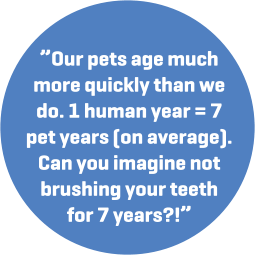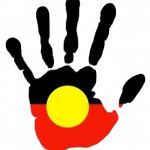
The ideal time to start a dental regimen is BEFORE you see signs of dental disease.
For adult cats and dogs with existing dental disease, a dental treatment involving a ‘scale and polish’ procedure under general anaesthetic is often necessary to get their mouth back into top condition. This will allow you to start your new routine with a ‘clean slate’, and which will hopefully prevent, or slow down the development of disease, and potentially reduce the number of veterinary dental treatments required in your pet’s lifetime.
There are many different methods of home-based teeth cleaning available including:
TOOTH BRUSHING
Daily brushing is THE best way to keep your pet’s mouth clean and healthy. Specially designed kinds of toothpaste (usually chicken or beef flavoured!) and a pet-friendly toothbrush can help in to removing plaque and preventing tartar build up. It is important to note that cats and dogs cannot use fluoride (human) toothpaste and a specific pet dental paste needs to be selected.
Most pets need to be trained to tolerate having their teeth brushed, but gradually developing a system is important. Cats and small dogs may feel more comfortable if they can sit on their owners’ lap while having their teeth brushed.
- Begin slowly – initial sessions should be brief, perhaps only a minute or two, and well rewarded.
- Get your pet used to the toothbrush by dipping it in tuna juice, chicken or beef stock – Yum!
- Next try offering the toothbrush with the paste, but without brushing. Allow your pet to taste the toothpaste (most pets really like it because it is flavoured).
- When your pet is comfortable with the toothbrush, try brushing one or two strokes on a few teeth. Slowly increase the amount of brushing as your pet becomes more comfortable.
- Start at the front of the mouth. Pets are often more accepting of this.
- The toothbrush bristles should be placed at the gum margin where the teeth and gums meet at a 45-degree angle. The movement should be in an oval pattern. Be sure to gently force the bristle ends into the area around the base of the tooth as well as into the space between the teeth.
DIET
Feeding your pet dry food rather than soft, mushy food may help to remove some of the soft plaque film from the teeth before it becomes calcified tartar.
Hills Science Diet T/d is a premium diet designed to help prevent tartar and plaque forming on the teeth. This food is ideal to start just after your pet’s teeth have been cleaned and it is available for both dogs and cats. The individual kibble pieces are larger than an averagely sized biscuit, which ensures the whole of the tooth is cleaned while the food is being crunched.

WATER ADDITIVES
These products work in two different ways: by decreasing overall bacterial loads in your pet’s mouth (thus aiding with smelly breath) and also softening plaque on the tooth surface. When the plaque is softer, it can be brushed away more easily.
Healthy Mouth Oral Solution has been clinically proven to be safe for all life stages and has the Veterinary Oral Health Council seal of approval. Add the correct measured amount of healthy mouth liquid to your pet’s drinking water.
DENTAL CHEWS
Greenies are made from vegetable matter, this product encourages your pets to chew, which helps to rub plaque off the tooth’s surface, and assists in spreading protective saliva around the teeth. Greenies are great for pets with digestive sensitivities and are available in many sizes.
Oravet chews contain a special ingredient called ‘Delmopinol’. Delmopinol works to form a preventive barrier that blocks bacteria, and the future formation of plaque and calculus (tartar) that builds up over time. Oravet chews are the first and only dental hygiene product for dogs that contain this special ingredient.
Raw bones – Feeding fresh raw bones and other animal products can greatly aid the hygiene of the mouth, however not every dog or cat can eat them due to individual medical conditions or gut sensitivities that prohibit their use within the diet.
- Un-cut bones are best to reduce the risk of dental fractures, and the size must be larger than your pet’s head to avoid them swallowing large portions.
- Cooked bones should NEVER be fed, as they are more likely to splinter and cause problems in the mouth, throat or gastrointestinal tract.
- Cut bones are more likely to fracture the teeth, and allow access to the fatty bone marrow that can cause tummy upsets and pancreatitis.
- Long bones such as a cow femur or a lamb femur bone are ideal for dogs.
- The part we want your pet to chew is the cartilage on the ends of the bone, NOT the bone itself. Once the cartilage has gone, it’s time for a new bone! Some pets can become severely constipated if they chew up and swallow lots of bones on a regular basis.
- Raw bones should be removed after an hour, as nasty bacteria can grow on the surface – and could cause serious harm if ingested. Once a bone has dried out, it can also become sharp to chew, and potentially cause damage to the teeth or the gastrointestinal tract.
- Always supervise your pet, especially the first time it has a different type of bone.
Using at least one oral health product each day can significantly reduce the amount of plaque and tartar build-up on your pet’s teeth, ensuring they stay happy and healthy!
Remember, it doesn’t have to be the same thing each day – It just has to be SOMETHING each day!




